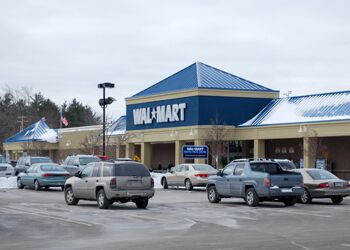Falmouth sets its eye on a new downtown
 Photo/Rebecca Goldfine
Falmouth town councilors recently opted not to prevent Walmart from expanding
Photo/Rebecca Goldfine
Falmouth town councilors recently opted not to prevent Walmart from expanding
At their first meeting in 2011, Falmouth town councilors put an end to any speculation that the town would curtail a planned expansion by the local Walmart, but said they might consider putting size limits on new developments.
"It became pretty clear that, from a consensus, we did not want to inhibit Walmart from expanding at its current location," council Chairman Tony Payne says. "The most compelling argument is that the Walmart is the retail anchor for the entire retail district."
The council had been considering a suggestion by three councilors to limit the footprint of big-box stores to 75,000 square feet, which would have halted Walmart's plans to move into adjacent space occupied by a Regal Entertainment Group cinema and add a grocery store, according to Payne. Walmart wants to expand its existing store by 36,000 square feet, bringing it to a total of about 120,000 square feet.
The council sub-committee, called the Community Development Committee, was not trying to deter big-box development in the upscale community as much as it was trying to refashion Falmouth's downtown shopping center, according to town planners.
"There has been a longtime discussion in Falmouth that we don't have a village center," says Amanda Stearns, the town's community development director.
Although Falmouth is an old New England community, settled in the 17th century, it doesn't have what many other Maine towns have: a quaint Main Street with historic brick buildings; fluttering awnings supplying shade for sidewalks; or even a town green. At the moment, it has a three-lane strip on Route 1 that bisects large parking lots and small strip malls filled with a mix of locally owned stores and chains.
Following guidelines in a 2005 town report on Route 1, the Community Development Committee has been hammering out ideas on how to reverse time. But the committee's proposal to limit retail footprints -- and Walmart's expansion -- to encourage denser development set off a small outcry.
Some business owners, such as Bill Sowles, who owns a Volkswagen dealership on Route 1, says Walmart is a retail magnet. "It is good for all businesses," he says. "Walmart draws out people from Portland, Windham, Yarmouth, from all sides of Falmouth; it pulls people in from out of town."
Had the council restricted the size of big-box stores, Payne says Walmart might have left. "I had spoken with one of the partners, and they were seriously considering having to go elsewhere. Their model for retail requires greater square footage, and even with the expansion, this would be one of the smaller Walmarts in the state," he says.
Now that that idea has been dropped, the subcommittee will turn to other proposals, according to Theo Holtwijk, the town's director of long-range planning. The council, for example, did not close the door on controlling the size of future big-box stores, he says. But there is also not much room left in the shopping area for any new large development.
"The overall idea is to transform Route 1 from an automobile service center to a more pedestrian-friendly, pedestrian-scaled New England center," Holtwijk says.
Without ripping up all the concrete and starting anew, only incremental steps can be taken, helping prod what Holtwijk calls a "gradual transformation over time." The committee is considering projects such as improving sidewalks, adding landscaping, planting trees, as well as building bicycle lanes and burying power lines. Members have also considered ways to encourage multiple-story construction, such as requiring a second story for any new construction. And, they'd like to see new buildings closer to the street, with parking lots behind them.
Falmouth does not have a downtown similar to Yarmouth, Wiscasset or other small coastal communities because of its evolution and geography, according to Holtwijk. "I am told that Falmouth really grew up along various village centers or corners, little hubs with corner stores," he explains. "It grew up in a somewhat disperse fashion, and I think that the coastal side, the Foreside, saw transportation up and down the coast. ... But it never really had a traditional downtown."
Holtwijk is asking for feedback on proposed zoning changes to Route 1 at the town's website, and a recent online survey has elicited diverse opinions on questions such as whether the town should restrict the size of new commercial buildings, he says. The town council will discuss the matter again at its Jan. 24 meeting.
Mike Skillin, who owns Skillin's Greenhouses on Route 88 in Falmouth, says he's unsure about implementing building caps. "I'm on the fence a little bit," he says. "I'm for higher density but also for more business development."
Others are wondering whether transforming the shopping village is feasible. Sowles says while he thinks remolding the area is a "courageous effort," he adds, "I'm not so sure the end result will be there. I don't see a lot of people walking up and down sidewalks on Route 1. People tend to get into their cars and go from one place to another."
But Holtwijk says if you look at any community a decade ago, you'll notice differences. "Look at how much change has happened over the last 10, 15 years, and how can you change a stretch of road. So you can imagine the potential for change in the next 10, 15 years," he insists. "We continue to see new buildings, renovated buildings. Every opportunity is an opportunity to change the town for the better."










Comments